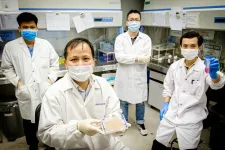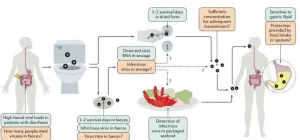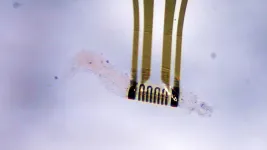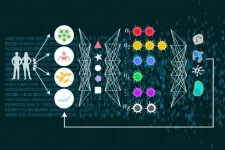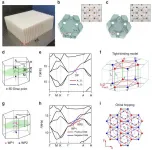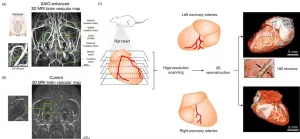(Press-News.org) When the body detects a pathogen, such as bacteria or viruses, it mounts an immune system response to fight this invader. In some people, the immune system overreacts, resulting in an overactive immune response that causes the body to injure itself, which may prove fatal in some cases.
Now, scientists from Nanyang Technological University, Singapore (NTU Singapore) have created a compound that could help to reduce this overactivation without impairing the body's entire immune response.
An overactive immune system leads to many autoimmune disorders - when the immune system mistakenly attacks healthy tissues - such as rheumatoid arthritis and type 1 diabetes. More recently, it has also been linked to severe COVID-19 infections, in which immune-system signalling proteins ramp up to dangerous levels, leading to damage to the body's own cells.
This compound designed by the NTU research team, called ASO-1, targets tyrosine kinase 2 (TYK2), a member from the Janus kinase (JAK) family of enzymes that play a key role in regulating the body's immune response. A recent study led by the University of Edinburgh and published in the leading scientific journal Nature found that high levels of TYK2 have been associated with severe COVID-19 .
Through lab experiments using human cells grown in a dish, the NTU scientists found that ASO-1 potently reduced TYK2 levels over a sustained period and inhibited immune signalling pathways that have been associated with autoimmune disorders.
This points to the potential of the ASO-1 compound forming the basis for treatment of autoimmune conditions, said the team led by Professor Phan Anh Tuan from NTU Singapore's School of Physical and Mathematical Sciences (SPMS).
Professor Phan, who is also the interim director of the NTU Institute of Structural Biology, said: "Human genetic studies have suggested that deactivating TYK2 could provide protection against a broad range of autoimmune conditions such as rheumatoid arthritis, psoriasis, lupus, and type 1 diabetes."
Dr Lim Kah Wai, NTU senior research fellow and co-lead author of the study, added: "With the UK-led study of critically ill COVID-19 patients published in Nature linking high TYK2 expression to severe COVID-19, ASO-1 could be a therapeutic agent worth investigating further. We are planning to conduct further pre-clinical work to validate its therapeutic potential."
The findings were published in February in the scientific journal ImmunoHorizons, a publication of The American Association of Immunologists, and the research team has filed a patent for the compound they designed.
Targeting genetic material that leads to TYK2 production
A number of drugs that reduce inflammation resulting from an overactive immune response target the Janus kinase (JAK) family of four proteins: JAK1, JAK2, JAK3 and TYK2.
Recently, TYK2 has emerged as researchers' preferred target. As the structures of the four members are highly similar, it is important to selectively target TYK2 to limit unwanted side effects.
The ASO-1 compound designed by the NTU research team is an antisense oligonucleotide (ASO). ASOs are a type of RNA therapeutics - they target the messenger RNA (mRNA), which carries genetic instructions that cells 'read' to make proteins. ASO-1 is designed to bind to TYK2 mRNA, thus preventing cells from producing TYK2 protein.
The research team conducted lab experiments on human cell cultures and found ASO-1 to be highly potent and selective for TYK2, with no effect against the other JAK proteins. Dr Lim noted that this high potency of ASO-1 rivals that of recent ASO drug candidates that have advanced to clinical trials or have been approved for clinical use.
The NTU team discovered ASO-1 from over 200 potentially effective ASOs, which were designed based on their in-house expertise on nucleic acids.
The team has established an integrated platform spanning the design, synthesis, and cellular testing of RNA therapeutics. TYK2 stands among a range of therapeutic targets for immunology and cancer therapy, which is the primary focus of the team.
The NTU researchers plan to partner several academic collaborators to test ASO-1 in animal models and are open to industrial collaboration on the development of the ASO-1 compound towards clinical use.
INFORMATION:
Note to Editors:
Paper 'Potent and Selective Knockdown of Tyrosine Kinase 2 by Antisense Oligonucleotides' published in ImmunoHorizons, February 2021, 5: 70-80.
doi.org/10.4049/immunohorizons.2000108
Media contact:
Foo Jie Ying
Manager, Corporate Communications Office
Nanyang Technological University
Email: jieying@ntu.edu.sg
About Nanyang Technological University, Singapore
A research-intensive public university, Nanyang Technological University, Singapore (NTU Singapore) has 33,000 undergraduate and postgraduate students in the Engineering, Business, Science, Humanities, Arts, & Social Sciences, and Graduate colleges. It also has a medical school, the Lee Kong Chian School of Medicine, established jointly with Imperial College London.
NTU is also home to world-class autonomous institutes - the National Institute of Education, S Rajaratnam School of International Studies, Earth Observatory of Singapore, and Singapore Centre for Environmental Life Sciences Engineering - and various leading research centres such as the Nanyang Environment & Water Research Institute (NEWRI) and Energy Research Institute @ NTU (ERI@N).
Ranked amongst the world's top universities by QS, NTU has also been named the world's top young university for the past seven years. The University's main campus is frequently listed among the Top 15 most beautiful university campuses in the world and has 57 Green Mark-certified (equivalent to LEED-certified) buildings, of which 95% are certified Green Mark Platinum. Apart from its main campus, NTU also has a campus in Novena, Singapore's healthcare district.
Under the NTU Smart Campus vision, the University harnesses the power of digital technology and tech-enabled solutions to support better learning and living experiences, the discovery of new knowledge, and the sustainability of resources.
For more information, visit http://www.ntu.edu.sg.
Recently, Prof. ZHU Shu from University of Science and Technology of China (USTC) of CAS and Prof. Richard A. Flavell from Yale University were invited to publish a review article in Nature Reviews Gastroenterology and Hepatology. They systematically summarized the gastrointestinal manifestations in patients with COVID-19 and explored the possible mechanisms of intestinal symptoms caused by COVID-19 infection.
Although the clinical manifestations of COVID-19 are primarily fever, cough, and pulmonary imaging, gastrointestinal symptoms have also ...
At the end of December 2019, Coronavirus Disease 2019 (COVID-19) quickly spread throughout Hubei Province and other parts of China. During the 2020 Spring Festival, public activities were cancelled, people tried their best to stay at home, and human and industrial activities were reduced to a basic or minimum level. However, during this period, severe fog-haze events occurred over the North China Plain. What was the leading factor that caused these severe smog incidents? And what were the individual impacts of meteorological conditions and emission reductions?
To evaluate the impacts of meteorological conditions and emission reduction measures on the near-surface PM2.5 (fine particulate matter) during the COVID-19 lockdown, ...
Flexible and adaptive microelectronics is considered an innovation driver for new and more effective biomedical applications. These include, for example, the treatment of damaged nerve bundles, chronic pain, or the control of artificial limbs. For this to work, close contact between electronics and neural tissue is essential for effective electrical and mechanical coupling. In addition, potential applications arise from the production of tiny and flexible surgical tools.
An international team led by Prof. Dr. Oliver G. Schmidt, head of the Institute for Integrative Nanosciences at the Leibniz Institute ...
Tokyo, Japan - Scientists from the Institute of Industrial Science at The University of Tokyo demonstrated how the adaptive immune system uses a method similar to reinforcement learning to control the immune reaction to repeat infections. This work may lead to significant improvements in vaccine development and interventions to boost the immune system.
In the human body, the adaptive immune system fights germs by remembering previous infections so it can respond quickly if the same pathogens return. This complex process depends on the cooperation of many ...
Recently, the three-dimensional (3D) Dirac points and 3D Dirac semimetals have attracted tremendous attention in the field of topological physics. The 3D Dirac point is a fourfold band crossing in 3D momentum space, which can be view as the degeneracy of two opposite Weyl points. However, the 3D Dirac points can be described by the Z2 topological invariant other than the Chern number. The topological property of 3D Dirac point is not totally the same as Weyl point. Besides, the transition from Dirac points to Weyl points has not been experimentally studied in both photonic and acoustic systems so far. Therefore, the theoretical or experimental breakthrough of 3D Dirac points and the study on their transition is of great ...
As countries around the world race to mitigate global warming by limiting carbon dioxide emissions, an unlikely source could be making climate goals harder to achieve without even deeper cuts in greenhouse gas production: reductions in air pollution.
New modeling experiments from Kyushu University in Japan of the long-term effects of reductions in pollutants known as sulfate aerosols predicts further increases in surface air temperature at current and increased carbon dioxide levels because of the loss of an overall cooling effect caused by the light-scattering particles.
"Air pollution causes an estimated seven million premature deaths per year worldwide, so action is essential, especially in emerging and developing countries, which tend to be most affected," ...
Heart attack and stroke are the first and second leading causes of death in developed countries, respectively. As the disease often results in sudden death with few special prognostic symptoms, early diagnosis is very important. For this purpose, imaging techniques such as magnetic resonance imaging (MRI) are widely used to identify the narrowing or blockage of blood vessels.
In MRI, contrast agents improve the visibility of the structures such as smaller blood vessels within the body. Just as satellites or global positioning systems (GPS) give traffic congestion information, the MRI contrast agents can give accurate information of vascular conditions such as vascular ...
A year ago, infectious disease doctor Christine Johnston was leading a study on the use of hydroxychloroquine for the treatment of people with COVID-19.
The trial launched at the end of March, when the disease was putting the world on pause and killing thousands.
Hydroxychloroquine showed promise in studies done in test tubes rather than in animals or humans. If the drug worked, it would be cheap, safe, and available. As the trial got going in April, however, hydroxychloroquine was being touted as a treatment without any rigorous evidence.
"The world was at a desperate moment and people were jumping to conclusions," ...
During the height of the first COVID-19 lockdown in the UK, women spent more time on unpaid housework and childcare than men, were more likely to reduce working hours, and reported higher levels of psychological distress, according to a new study published last week in the open-access journal PLOS ONE by Baowen Xue and Anne McMunn of University College London, UK.
Before the COVID-19 pandemic, studies had already shown that women in the UK today spend more time doing unpaid care work than men. In March 2020, childcare facilities and schools in the UK were shut down in response ...
Young people at ultra-high risk of developing psychosis have significantly higher psychotic symptoms if they are an evening person, researchers at Orygen, Australia's centre of excellence in youth mental health, have found.
Their research, published last month in the journal Early Intervention in Psychiatry, investigated the link between sleep disturbance, chronotype - whether the young person was a morning or evening person - and psychotic symptoms.
Orygen's Dr Jessica Hartmann, who led the study, said the research involved clinical interviews and self-report ...
